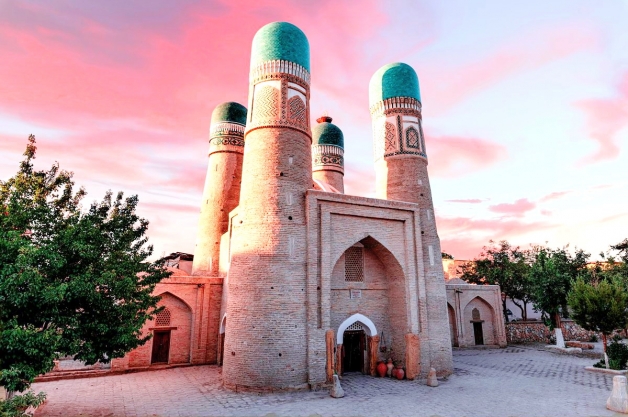Chor Minor Madrasah, Bukhara
The Chor Minor Madrasah in Bukhara is one of the most remarkable historical monuments of the town. Located behind the Lyab-i Hauz complex, it is especially outstanding compared to the rest of the square in its unusual forms and architectural design, which accounts for its name.
"Chor Minor" means "four minarets" in Persian. These are small angle towers with azure-blue domes surrounding the square-rectangular building. But in contrast to traditional minarets, which suggest the possibility of ascending the "muezzin" to the open platform for the convocation to prayer, in Chor Minor it is missing. The decoration is curious as well. At first glance, the towers seem identical, but on closer examination, you will see that the decoration of none of them is the same as the other.
There are several opinions about the sacred message behind the construction of such a peculiar building of four minarets:
-
An attempt to reinterpret the four world religions; for example, elements representing a cross and a fish are attributes of Christian symbolism, while the prayer drums are of Buddhism.
-
The towers symbolize the four dynasties of the Bukhara rulers: Samanids, Sheibanids, Karakhanids, and Mangyts.
-
The minarets are dedicated to the four children of Khalif Niyaz-kul.
The supposed date of construction is 1807 and at the expense of the philanthropist of Turkmen origin Khalif Niyaz-kul. According to some theories, the surviving structure is a part of the gateway from the once-existing madrasah complex.
The central building of the ensemble, the one topped with towers, was intended for a mosque. Despite its non-standard exterior decoration, its interior looks typical for the local area. Five "namaz" prayers, one of the five pillars of Islam, were performed here daily. The presence of the dome allowed the hall to be used as a "zikrhona" - a place for rituals and ceremonies of the oriental mystics of "Sufis" which included recitation, chanting, and instrumental accompaniment.
The side part of the building consisted of residential rooms "hujras." It is assumed that the number of students in the madrasah was quite small or it was used as a dormitory for about 20 students. The second floor and three towers contained service rooms, while the fourth minaret was a depository of a rich library.
The madrasah is widely known outside the country and is often depicted on postcards and souvenir products. A visit to the Chor Minor is a must on the Bukhara tourist program, appealing to its uniqueness and beauty. In front of the entrance to the madrasah, there is a small courtyard with a cozy garden where even in November roses bloom with a pleasant fragrance. Chor Minor is one of the most ancient parts of the town, untouched by civilization where everything breathes with antiquity!









